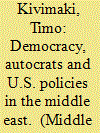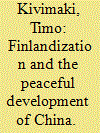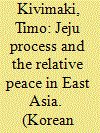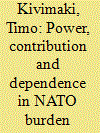| Srl | Item |
| 1 |
ID:
112115


|
|
|
| 2 |
ID:
097776


|
|
|
|
|
| Publication |
2010.
|
| Summary/Abstract |
There has been a staggering decline in battle deaths in East Asia. Several recent studies have testified to this trend by referring to it as East Asian Peace. The decline in traditional conflict battle deaths does not, however, constitute peace. It could be possible that battle deaths have merely moved to less traditional types of conflict. The purpose of this article is to see whether the decline in battle deaths has brought about genuine peace.
|
|
|
|
|
|
|
|
|
|
|
|
|
|
|
|
| 3 |
ID:
101961


|
|
|
|
|
| Publication |
2011.
|
| Summary/Abstract |
East Asia has experienced a drastic decline in incidences of warfare and has had exceptionally low levels of battle deaths after 1979. However, East Asian peace had already begun in 1967 inside ASEAN. Is it possible that East Asian peace began in ASEAN and spread to the rest of East Asia? This is the question that this article aims to tackle by showing the association between a reasonable and plausible explanation, the ASEAN Way, and East Asian peace after 1979. The argument about the role of the ASEAN approach in the pacification of East Asia is based on an examination of the patterns of frequency of conflicts, numbers of battle deaths and conflict termination. In this kind of examination, it seems that the recipes for peace in East Asia after 1979 are similar to those of ASEAN after 1967, and that their relationship to conflicts was also very similar.
|
|
|
|
|
|
|
|
|
|
|
|
|
|
|
|
| 4 |
ID:
139157


|
|
|
|
|
| Summary/Abstract |
The rise of China has brought about new considerations and a debate in East Asian security studies. Several of the countries neighbouring China have been probed for their degree of ‘Finlandization’, as manifest in excessive attentiveness to the interests of a neighbouring great power, due to the power asymmetry between the ‘Finlandized’ and the ‘Finlandizer’. This article will scrutinize Finlandization and determine to what extent the power relationship between Finland and the Soviet Union can be compared with the emerging power relationship that China’s East Asian neighbours will have to tackle. Furthermore, this article will seek from the Finnish experience lessons for East Asia on how to adapt to power realities without making the mistakes that Finland and the Soviet Union made in their relationship. China’s East Asian neighbours could learn how to avoid compromising their autonomy from Finland’s mistakes. They could also learn from Finnish realism how to tackle the security dilemma that the rise of Chinese power involves, and how to seek security in a way that would not make the rising great power feel any less secure.
|
|
|
|
|
|
|
|
|
|
|
|
|
|
|
|
| 5 |
ID:
099680


|
|
|
|
|
| Publication |
2010.
|
| Summary/Abstract |
South Korea's contribution to international peace has been on various levels, including official activities and unofficial ones. Furthermore, while its contribution has often been focused on security on the Korean peninsula, the Republic of Korea (ROK) has also contributed to a wider security environment globally and regionally. One of the major instruments of regional East Asian unofficial diplomacy has been the Jeju Process. This article focuses on the contribution of this forum to the relative peace in East Asia by first looking at what kind of activity the Jeju Process represents, and whether East Asian initiatives in general have an impact on East Asian security; or is East Asian security simply determined by global politics? Secondly, it will look at what the regional security is built on and what the main challenges are to that security. Finally, it will then look at how the types of activities that the Jeju Process represents affect the security challenges in East Asia. This paper adopts a long-term perspective and defines the security patterns and the challenges as megatrends, rather than looking at each of the immediate concerns the region has.
|
|
|
|
|
|
|
|
|
|
|
|
|
|
|
|
| 6 |
ID:
164653


|
|
|
|
|
| Summary/Abstract |
This article offers three new types of variables for computation of the share that NATO countries should contribute to the common defence. I use Uppsala conflict data (UCDP) on conflict participation to reveal how the asymmetry in power that allows the US to define most of the framings on which NATO’s utility calculations are based, compensates for the greater material contribution made to NATO by the US. Then I follow Ringsmose’s model of NATO burden sharing and create two types of variables crucial to the calculation of burden sharing. One reveals the share of US military protection aimed at protecting its NATO allies. The other measures how much US global security efforts against tyranny and terror are dependent on NATO allies. These two variables are developed by means of computer-assisted discourse analysis of US Presidential Papers. The three new variables contribute to a more complex mathematical model on fair burden sharing, indicating at the same time that the imbalance between US and allied contributions is declining. If European allies have ever exploited the United States in the past, then at least the relationship has become more even during the past two decades.
|
|
|
|
|
|
|
|
|
|
|
|
|
|
|
|
| 7 |
ID:
083488


|
|
|
|
|
| Publication |
2008.
|
| Summary/Abstract |
This article attempts to build on insights on scholarship that tries to explain the successfulness of ASEAN and tries to produce some tested conclusions on what it is that explains ASEAN's success best. This is done by using slightly stricter criteria of explanation that has been used before and by exploiting the newest quantitative data on conflicts. Stricter explanation is attempted through greater care in defining the variables of explanation, as well as by trying to avoid the Western biases that many of the existing international relations theories have. When explaining how ASEAN manages to reach many of its political objectives, the focus in this article is on material realties as well as perceived and constructed ones. The explanation attempts to be careful in assessing what is to be explained. This is why this article first defines the criteria of success by looking at what it is that ASEAN attempts to do and then employs the quantitative data to see whether the existence of ASEAN is correlated to the desired outcomes. At the end of this article, the concluding explanation of ASEAN will be relativized by looking at the new challenges to which ASEAN should or could respond. The elitism of the 'old ASEAN Way' will need to give way to a more broad-based approach to stability, if ASEAN wants to remain relevant as an organization in the future.
|
|
|
|
|
|
|
|
|
|
|
|
|
|
|
|
| 8 |
ID:
053663


|
|
|
| 9 |
ID:
135267


|
|
|
|
|
| Summary/Abstract |
Recent Anglo-American scholarship suggests that China’s soft power strategy has failed the country. Chinese culture and values have not gained their expected appeal, and China has failed to create an alliance structure similar to that of the United States in support of its leadership. This article suggests a reinterpretation of the evidence by means of recontextualising the concepts of soft power and global governance in the context of China’s undertaking of a peaceful ascension. China’s approach to, and objectives in world affairs are different from those of the United States, and therefore China’s soft power strategy cannot be evaluated using an American yardstick. If analysed according to China’s specific objectives and the world in which China lives, one can see that China’s soft power serves the country relatively well.
|
|
|
|
|
|
|
|
|
|
|
|
|
|
|
|
| 10 |
ID:
115015


|
|
|
|
|
| Publication |
2012.
|
| Summary/Abstract |
Amitav Acharya and Barry Buzan wrote in volume seven of this journal that 'the main ideas in this discipline (of international relations) are deeply rooted in the particularities and peculiarities of European history, the rise of the West to world power, and the imposition of its own political structure onto the rest of the world.' Taking this claim as the starting point the intention of this article is to see where international relations theory over-generalizes and how it could learn from the alternative experience of East Asia. The main focus of the critique will be on two central ideas: first, the idea that unrestricted state sovereignty is necessarily a problem and a security dilemma in international relations; and second, the idea that there is a need for global hierarchy and hegemony in order to tackle the security dilemma. The article uses qualitative scholarship on the dynamics and structures of peace as the point of departure and then assesses the plausibility of these ideas quantitatively using two data sets, the Correlates of War and the PRIO/Uppsala data set (1946-2008).
|
|
|
|
|
|
|
|
|
|
|
|
|
|
|
|
| 11 |
ID:
048224


|
|
|
|
|
| Publication |
Aldershot, Ashgate, 2003.
|
| Description |
viii, 300p.
|
| Standard Number |
0754636860
|
|
|
|
|
|
|
|
|
|
|
|
Copies: C:1/I:0,R:0,Q:0
Circulation
| Accession# | Call# | Current Location | Status | Policy | Location |
| 047214 | 327.598073/KIV 047214 | Main | On Shelf | General | |
|
|
|
|
| 12 |
ID:
052939


|
|
|
|
|
| Publication |
Denmark, Nordic Institute of Asian Studies(NIAS), 2002.
|
| Description |
vii, 213p.Paperback
|
| Standard Number |
8791114012
|
|
|
|
|
|
|
|
|
|
|
|
Copies: C:2/I:0,R:0,Q:0
Circulation
| Accession# | Call# | Current Location | Status | Policy | Location |
| 046394 | 327.160916472/KIV 046394 | Main | On Shelf | General | |
| 054456 | 327.160916472/KIV 054456 | Main | On Shelf | General | |
|
|
|
|